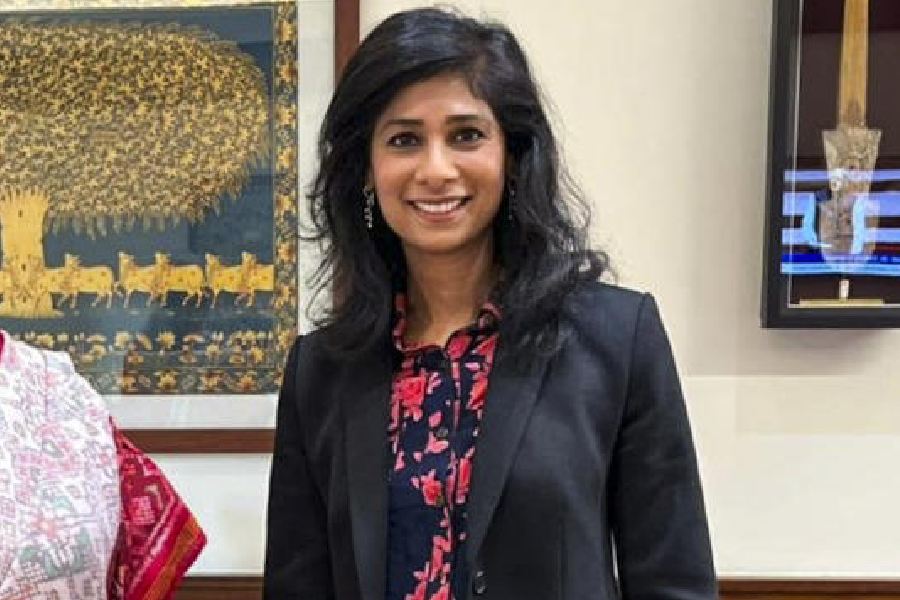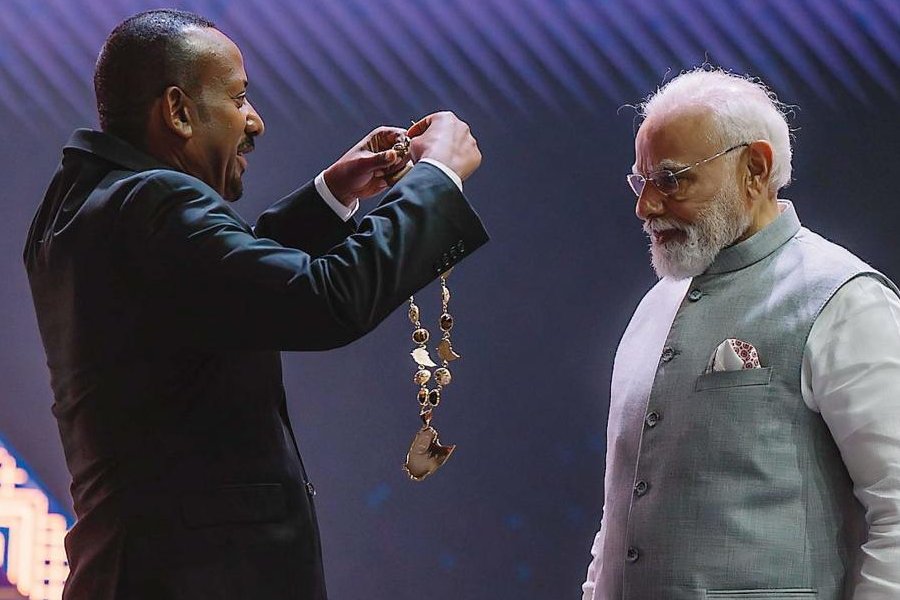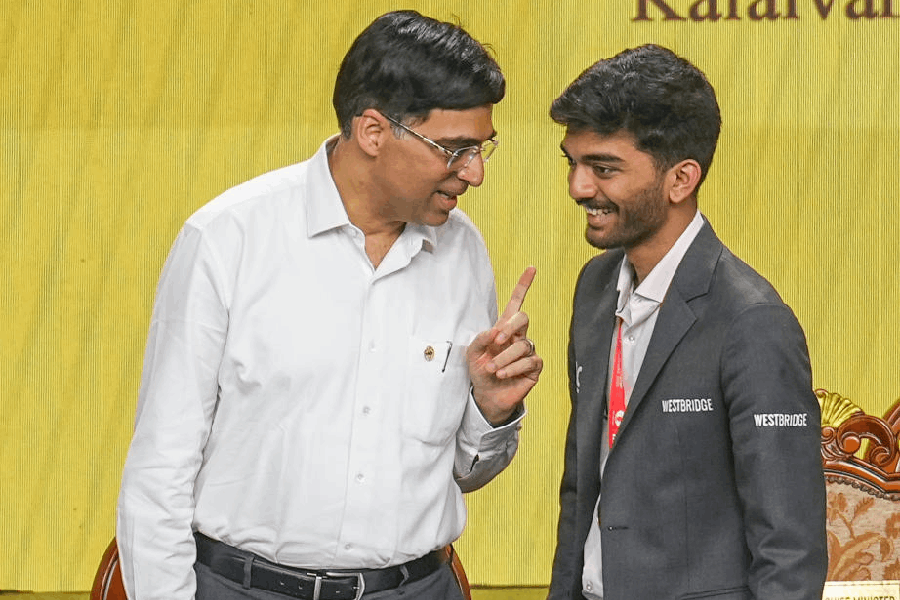 |
The earring is, well, a bit different. But then, so is Shubhashis Gangopadhyay, adviser to the finance minister and, at 50, the youngest person to hold that post.
The first floor room in North Block, which houses the finance ministry, hasn’t changed much from the time Gangophadyay’s predecessor Partho Shome occupied it. There’s the same heavy wooden furniture and the table cluttered with papers. But the occupants are markedly different in their sartorial styles. The short, heavy set, formally attired Shome has given way to the lean and lanky Gangopadhyay clad in a maroon handloom kurta and a white churidar — and sporting a tiny earring on his left ear.
It’s a gift from daughter Ishanti who’s just graduated in psychology from Clark University in the United States, and the father wears it rather nonchalantly. Weren’t there any gentle hints from the government urging him to blend with the rest of babudom, which, it must be said, is not quite known for men who wear earrings? None, he says. “India is a very different country in many ways. I think we are internalising the wrong things about the country.”
And, he adds, if anyone had asked him to remove the stud before entering the starchy environs of North Block, it would have been fine with him. Does he mean he would have removed the earring, I start to ask, but he goes on: “…I will not work in the government.” But he wouldn’t have considered the request conservative either. “I will just think that you could have had a guy who was passionate about the work and you are losing him because of an earring. The problem is yours.”
Not conforming to fashion is an old habit. Back in Calcutta in the mid-1970s, as an economics student at Presidency College, he remained aloof from the extreme Left wave that most Calcutta youth jumped into. “Don’t slander Calcuttans,” he rebukes when I ask him about this, pointing out that there were many who stayed away from the Naxalite movement. But didn’t he get caught up in the romanticism of the Left? “In college, I was indulging in real romance, not this,” he says pushing back his straight hair that keeps falling on his forehead and laughing uproariously.
The appearance and the banter lighten the formidable reputation as an economist that he brings to the table. The credit goes in no small measure to his mother — “the real person behind all of us” — who studied only up to class six but “worked like crazy” to ensure that her four children got the best of education after her husband, a government scientist, died at 43. Shubhashis, the youngest, was just four. Schooling was at no less than Calcutta Boys’ School, with Presidency the next stop. While still in his second year, he got selected for Cornell University in the United States and was told to join after completing his graduation, which he did the next year — 1978.
Five years later, with a PhD under his belt, he returned to India, when it wasn’t fashionable to do so. Indian music was one of the pull factors — he loves classical music. Wife Kasturi is a trained singer and dancer (they met at one of her performances) and their daughter is a trained Carnatic music singer.
He landed a job at the Indian Statistical Institute (ISI) in Delhi and, over the next 19 years, earned his stripes as a researcher, posing questions on the basis of real development concerns. “ISI was the best place to work for a researcher. Nobody told you what to do.”
But he was disturbed by the gap between what researchers did and what was happening in the country — reinforcing their image of ivory tower number crunchers. But the problem, he says, wasn’t of their making. Researchers, he stresses, want to be involved in policy but don’t have access to information because of the opacity surrounding policy making in India. He returned from the US to work on policy but became an out-and-out theorist because there was no data, or support for data work.
The urge to do something to break that gap between academia and the real world didn’t leave him, though. Nor did his dream to set up a research institute. He decided to take the plunge and do both in 2002, quitting his secure job to start the India Development Foundation (IDF), to undertake research on market solutions to developmental problems.
“At IDF, our starting point is that markets work ,” he says. And though he never got drawn to the Left, he thinks it poses the right questions. His answers, however, are different: he believes the market allows individuals to solve their own problems.
Not everybody, he admits, will benefit from the market because there are entry barriers in the form of caste, lack of education and of funds. Development must reduce those barriers and allow people to enter the market. “Society’s job,” he says, “is not to make you a millionaire but to make sure you can make your choices.” Inclusive growth (he scoffs at the slogan), he is sure, will take place only in a good market society.
IDF lived up to his promise to bridge the gap between research and the real world. Two ideas thrown up through its research are being implemented as pilot projects by the government. One is a health smart card — an electronic medical record that enables patients to get standardised treatment wherever they go. The other is a new financial instrument for small plantation owners, which provides them with relief in times of crisis.
It is also engaged in developing a poverty mapping technology jointly with the World Bank and the government which will help identify pockets of underdevelopment within districts so that resources can be targeted in a more focused manner.
It’s probably this body of work that caught the attention of the finance minister, looking for a replacement for Shome, who joined the British government as an economic adviser earlier this year. In early January, Gangopadhyay received a call out of the blue, first from a ministry official and then from the minister himself offering him Shome’s job. Five days later, Gangopadhyay was occupying his room. “I have been associated with the government but always from the outside. I thought it would be a good experience to see how it works from the inside.” Getting a ringside view of the real political processes in the government is something he finds refreshing and very different from the work he’s been doing till now.
But there’s a price he’s paying — three hours daily in traffic, commuting from his Gurgaon residence to his central Delhi office and back. It bothers him, especially since he’d always lived just 10 minutes away from his work place. “I am a miser when it comes to time. I’m basically a very lazy guy and like to do a lot of things that don’t involve work.” That includes reading, solving crossword puzzles, listening to music and spending hours in front of the television. A football freak, he watches all sports — except golf. He’s also addicted to TV commercials and watches them even when he’s abroad, putting the TV on mute when he doesn’t understand the local language. He’s partial, though, to Indian ads, which he finds very imaginative.
He had ample time to do all this earlier, even after putting in 12 hours at work, waking up at 3.30 am, working from 4 am to 6 am and reaching office by 7.30 am. He never works after 7 pm “as a matter of principle” and is in bed by 10.30 pm.
Five hours of sleep is enough for him. He can, he says, go without sleeping for two or three days, with no one any wiser. But he can also sleep for 48 hours at a stretch. With the economy giving sleepless nights to economic managers, maybe that’s another asset he brings to his job.










